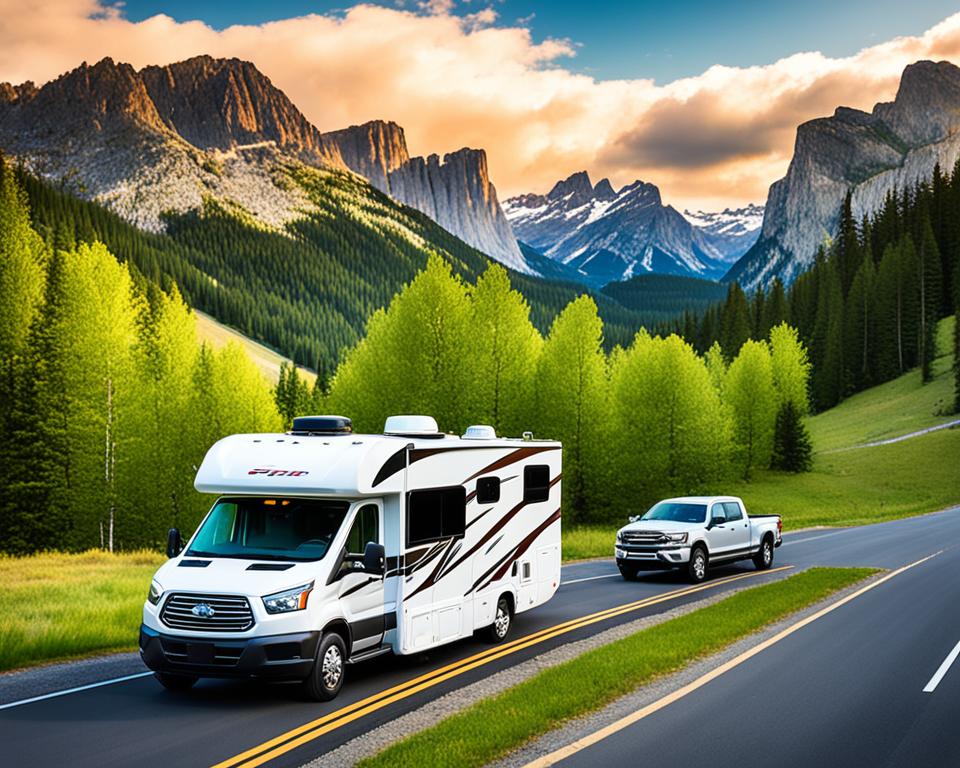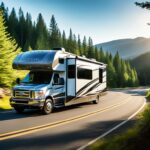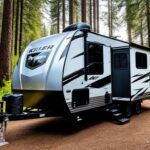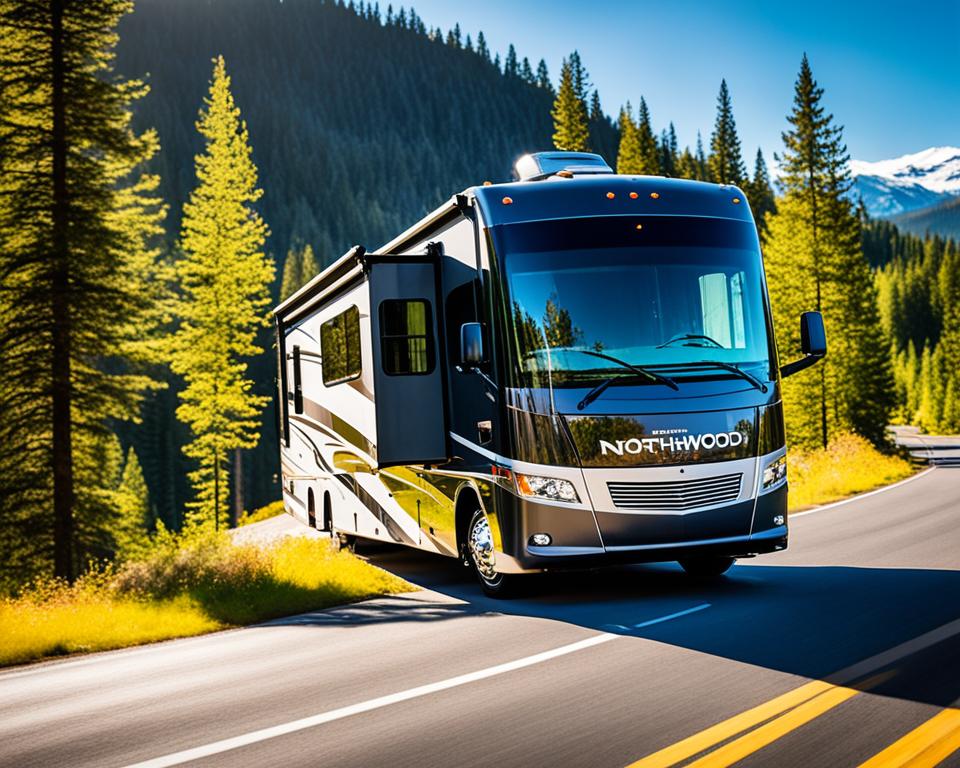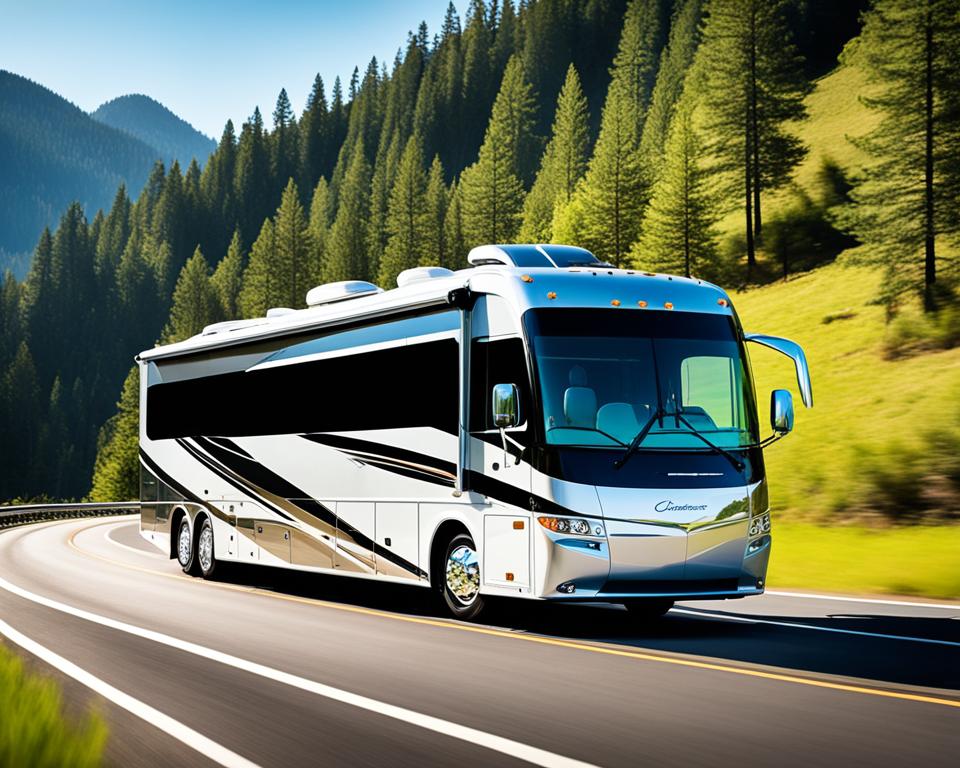Towing an RV can be both exciting and daunting, especially for beginners. The thought of maneuvering a large vehicle on the road and properly hitching it may seem overwhelming. However, with the right knowledge and tips, RV towing can become a manageable and safe experience.
This comprehensive guide will provide you with the best practices for towing and hitching an RV. From choosing the right equipment to mastering proper hitching techniques, weight distribution, braking, and safe driving, we’ve got you covered. By following these tips and guidelines, you’ll be well-equipped to hit the road with confidence.
Key Takeaways:
- Follow the best practices outlined in this guide for safe and efficient RV towing.
- Choose the right towing equipment that matches your vehicle’s towing capacity and the weight of your load.
- Master proper hitching techniques for various types of trailers, including travel trailers and fifth wheels.
- Understand the importance of weight distribution and trailer loading for stability and safety.
- Implement proper braking techniques and adjust your driving style for towing.
Choosing the Right Equipment for Towing
Before embarking on any towing journey, it is crucial to ensure that you have the right equipment to ensure a safe and successful trip. Here are some key factors to consider when selecting your RV towing equipment:
- Towing Capacity: Determine the towing capacity of your vehicle. This information can typically be found in your vehicle’s owner’s manual or by consulting the manufacturer’s website. Knowing your vehicle’s towing capacity will help you choose the appropriate equipment.
- Hitch Selection: Selecting the right hitch for your towing needs is essential. There are various types of hitches available, such as weight distribution hitches, gooseneck hitches, and fifth wheel hitches. Consider the weight of your load and the towing capacity of your vehicle when making your selection.
- Tow Bars: If you are towing a vehicle behind your RV, you will need tow bars. These bars connect your RV to the towed vehicle and safely guide it along during the journey. Choose tow bars that are compatible with both your RV and the towed vehicle.
- Weight Distribution: Proper weight distribution is crucial for safe and stable towing. Weight distribution hitch systems can help distribute the weight of your load evenly between your RV and tow vehicle. This will help optimize handling and minimize the risk of trailer sway.
For certain types of RVs, such as fifth-wheel trailers, it is important to properly select and install a compatible fifth wheel hitch. This type of hitch provides increased stability and maneuverability when towing a large RV.
“Choosing the right equipment is the first step towards a safe and successful towing experience. Taking the time to understand your vehicle’s towing capacity, selecting the appropriate hitch, and ensuring proper weight distribution will help you tow your RV with confidence.”
In summary, selecting the right equipment for towing your RV is essential for a safe and enjoyable journey. Consider the towing capacity of your vehicle, choose the appropriate hitch and tow bars, and ensure proper weight distribution. By taking these steps, you will set yourself up for a smooth and worry-free towing experience.
| Equipment | Description |
|---|---|
| Towing Capacity | Understand your vehicle’s towing capacity to determine weight limits. |
| Hitch Selection | Choose the right type of hitch based on your towing needs and vehicle specifications. |
| Tow Bars | Select tow bars that are compatible with your RV and towed vehicle. |
| Weight Distribution | Ensure proper weight distribution to optimize handling and minimize trailer sway. |
Proper Hitching Techniques
Hitching your RV correctly is crucial for a safe towing experience. This section will provide step-by-step instructions and tips on properly hitching different types of trailers, including travel trailers and fifth wheels. It will cover important aspects such as connecting safety chains, adjusting tongue weight, and measuring the height of your trailer to ensure proper clearance.
Hitching a Trailer
When hitching a trailer, it’s important to follow these steps:
- Position the trailer ball under the hitch coupler.
- Lower the coupler onto the ball and secure it by locking the latch.
- Attach the safety chains to the tow vehicle using appropriate hooks or connectors.
- Connect the trailer’s electrical plug to the tow vehicle’s hitch.
- Ensure the trailer is properly leveled by adjusting the trailer tongue height.
Hitching a Fifth Wheel
If you have a fifth wheel trailer, follow these steps for proper hitching:
- Back your tow vehicle underneath the fifth wheel hitch, aligning the kingpin with the hitch plate.
- Lower the trailer onto the hitch plate and secure it using the hitch lock mechanism.
- Attach the safety chains to the tow vehicle.
- Connect the electrical plug between the trailer and tow vehicle.
- Adjust the trailer’s height to achieve proper clearance.
Remember to always consult your RV owner’s manual and hitch manufacturer’s instructions for specific guidance on hitching procedures and safety precautions.
Safety Chains and Tongue Weight
In addition to proper hitching, ensure that your safety chains are securely attached to the tow vehicle, crossed under the hitch, and connected to the trailer. Safety chains provide an extra layer of security in case the trailer becomes disconnected.
Adjusting tongue weight is essential for maintaining stability while towing. This refers to the amount of weight exerted on the hitch ball by the trailer’s tongue. Ideally, tongue weight should be around 10-15% of the trailer’s total weight. Use a tongue scale or consult your RV’s specifications for accurate measurements.
Height Measurement
Before hitting the road, it’s important to measure the height of your trailer to ensure proper clearance. Use a measuring tape or a specialized height measurement device to determine the distance from the ground to the highest point of the trailer, including any rooftop accessories. Compare this measurement to any low-clearance obstacles along your planned route to avoid accidents or damage.
| Proper Hitching Techniques | Benefits |
|---|---|
| Follow step-by-step instructions for hitching a trailer or fifth wheel. | Ensures a secure connection between the tow vehicle and trailer. |
| Connect safety chains and adjust tongue weight appropriately. | Enhances towing stability and provides a safety backup in case of hitch failure. |
| Measure the height of your trailer for clearance considerations. | Prevents damage to the trailer from low obstacles and bridges. |
Weight Distribution and Trailer Loading
Proper weight distribution and trailer loading are crucial for a safe and stable towing experience. When towing an RV, it’s important to ensure that the weight is evenly distributed from front to back and side to side. This helps maintain control of the trailer and minimizes the risk of trailer sway, which can be dangerous and difficult to control.
One of the key factors to consider when achieving even weight distribution is tongue weight. Tongue weight refers to the downward force exerted on the hitch ball by the trailer’s tongue. It should typically be around 10-15% of the trailer’s total weight. Too much or too little tongue weight can negatively impact trailer stability, causing it to sway or fishtail.
Tip: To measure tongue weight, you can use a tongue weight scale or visit a local trailer dealer or mechanic who can assist you.
To achieve even weight distribution and proper tongue weight, it’s important to load your trailer correctly. Start by placing the heaviest items over or just ahead of the trailer’s axles. This helps distribute the weight evenly and prevents excessive strain on the tow vehicle’s rear axle. Lighter items can be placed towards the front and back of the trailer, keeping in mind the recommended tongue weight percentage.
When loading your trailer, be mindful of the overall weight as well. Overloading your trailer can lead to poor handling, decreased braking performance, and potential damage to the trailer or tow vehicle. Only pack necessary items and avoid carrying excess weight that can put unnecessary strain on the towing setup.
By ensuring proper weight distribution and trailer loading, you can minimize the risk of trailer sway, improve towing stability, and enhance overall safety on the road.
| Benefits of Proper Weight Distribution and Trailer Loading | Consequences of Improper Weight Distribution and Trailer Loading |
|---|---|
|
|
Braking Techniques for Towing
Braking while towing requires special attention and techniques to ensure safe stopping. Properly adjusting and maintaining your brakes is crucial for a smooth and controlled towing experience. This section will cover essential topics related to towing brakes, brake controllers, brake adjustment, and the trailer brake battery. By understanding and implementing these braking techniques, you can enhance the safety and performance of your towing setup.
Brake Controller Settings
Brake controller is a key component in towing setups, as it allows you to control the trailer brakes independently from your vehicle’s brakes. It’s essential to adjust and set your brake controller according to the weight of your trailer. The brake controller should be set to a level that provides enough braking force without causing the trailer brakes to lock up. Refer to your brake controller’s manual for specific instructions on adjusting the settings.
Proper Brake Adjustment
Ensuring that your brakes are properly adjusted is crucial for safe and effective braking. Over time, brakes can wear down and require adjustments to maintain optimal performance. Regularly inspect your brakes and adjust them according to the manufacturer’s guidelines. Proper brake adjustment helps to prevent excessive wear on the towing vehicle’s brakes and promotes balanced braking between the vehicle and trailer.
Testing Brake Intensity
To ensure that your brakes are functioning correctly, it’s important to periodically test the intensity of the brakes. This can be done by applying the brakes gradually and observing the response from both the towing vehicle and the trailer. The braking force should be evenly distributed between the vehicle and the trailer, without any excessive pulling or swerving. If you notice any abnormalities, such as uneven braking or trailer sway, it may indicate an issue with your braking system that requires further inspection and adjustment.
Checking the Brake Battery
The trailer brake battery plays a vital role in ensuring your trailer’s braking system is operable. It’s essential to regularly check the brake battery’s charge to avoid any unexpected brake failure during towing. A low or discharged battery can result in compromised braking performance. Refer to your trailer’s manual for instructions on checking and maintaining the brake battery’s charge.
| Topic | Description |
|---|---|
| Brake Controller Settings | Adjust and set the brake controller for optimal braking force. |
| Proper Brake Adjustment | Regularly inspect and adjust the brakes to maintain optimal performance. |
| Testing Brake Intensity | Periodically test the braking force and observe for any abnormalities. |
| Checking the Brake Battery | Regularly check the brake battery’s charge to ensure proper braking. |
Driving and Maneuvering Tips
Driving and maneuvering with a trailer requires extra caution and awareness. To ensure a safe towing experience, it is important to follow specific driving techniques and adapt your driving style accordingly.
Safe driving techniques while towing
When towing a trailer, it is crucial to maintain a safe driving technique to ensure the safety of yourself, your passengers, and other road users. Consider the following tips:
- Keep a safe distance from other vehicles to allow for longer stopping distances in case of emergencies.
- Slow down and adhere to speed limits, as towing a trailer increases the overall weight and affects your vehicle’s handling.
- Drive more defensively and anticipate potential hazards or sudden braking situations.
Turning with a trailer
Turning with a trailer requires a wider turning radius compared to driving without a trailer. To make safe turns:
- Take wider turns to prevent the trailer from hitting curbs or obstacles.
- Use your tow mirrors for better visibility, especially when making right turns.
Changing lanes
Changing lanes while towing a trailer requires extra attention and caution:
- Check your blind spots carefully by using both your side mirrors and tow mirrors.
- Signal well in advance to indicate your intention to change lanes.
- Take into account the additional length and width of your trailer when assessing lane change opportunities.
Safe passing
When passing other vehicles on the road:
- Ensure you have enough space and time to pass safely.
- Use your signals to indicate your intention to pass.
- Accelerate steadily and smoothly to overtake the vehicle in front of you.
Driving on slopes
Driving on slopes or inclines requires careful control and attentiveness:
- Be aware of the additional strain on your vehicle’s engine when towing uphill.
- Ensure your vehicle has enough power to climb the slope without overexertion.
- When descending, use lower gears and engine braking to control your speed and prevent excessive strain on the brakes.
Incorporating these safe driving techniques while towing a trailer will contribute to a smoother and safer towing experience. Keep in mind that practice and experience are key to improving your towing skills and confidence on the road.
| Safe Driving Tips While Towing |
|---|
| Keep a safe distance from other vehicles. |
| Drive more defensively and anticipate hazards. |
| Take wider turns to accommodate the trailer. |
| Use tow mirrors for improved visibility. |
| Check blind spots when changing lanes. |
| Signal and accelerate smoothly when passing. |
| Be cautious when driving on slopes. |
Route Planning and Height Clearance
Proper route planning is essential when towing an RV. One of the critical factors to consider is height clearance to avoid accidents and damage caused by low bridges and other obstructions. Being mindful of your RV’s height and clearance will ensure a safe and smooth journey.
For a stress-free travel experience, consider using an RV-specific GPS. These GPS devices are designed to factor in your RV’s size, weight, and driving preferences when selecting routes. By inputting your RV’s specifications, you can rest assured that the GPS will guide you through routes that are suitable for your vehicle.
An RV-specific GPS can also alert you to low-height bridges and narrow roads, helping you avoid potential hazards. The GPS will provide alternative routes that are better suited to your RV’s size and height clearance, ensuring a worry-free journey.

| Benefits of using an RV-specific GPS for route planning: |
|---|
| 1. Safety: The GPS takes into account your RV’s size, ensuring you travel on routes with sufficient height clearance and avoid low bridges. |
| 2. Convenience: The GPS provides easy-to-follow navigation instructions tailored to your RV, making your journey more enjoyable and stress-free. |
| 3. Time and Fuel Efficiency: By selecting routes specifically designed for RVs, you can save time and fuel by avoiding unnecessary detours or backtracking. |
| 4. Confidence: Knowing that your GPS is guiding you on the best and safest route for your RV allows you to travel with peace of mind. |
Route planning and height clearance are crucial elements of RV towing. By utilizing an RV-specific GPS and ensuring you have accurate knowledge of your RV’s height, you can avoid any unexpected obstacles and have a smooth and enjoyable journey.
Parking and Campsite Considerations
Parking an RV with a trailer and selecting the right campsite are important aspects of a successful RV trip. These considerations require careful planning and attention to detail to ensure a smooth and enjoyable experience. Here are some tips to help you navigate parking with a trailer and choose the perfect campsite for your RV:
Parking with a Trailer
When parking your RV with a trailer, it’s crucial to select a spot that offers enough space for maneuvering and making complete turnarounds. Look for wider parking areas or campsites that provide ample room to accommodate the length of your RV and trailer combination. This will make it easier to park and unhitch, reducing the chances of any accidental damage.
Campsite Selection
Before embarking on your RV adventure, it’s essential to research and select campsites that meet your specific needs and preferences. Consider factors such as location, amenities, and attractions nearby. Additionally, take into account the length requirements for campsites to ensure they can accommodate both your RV and trailer comfortably.
Flat Campsite
When choosing a campsite, prioritize finding a flat and level area to park your RV and set up your camp. A level campsite not only ensures better stability for your RV but also makes it easier to stabilize your trailer and prevents any uncomfortable tilting or unnecessary strain on the RV’s components.
Obstructions
Prior to parking your RV, carefully examine the area for any potential obstructions that could pose challenges during the parking process. Look out for low-hanging branches, rocks, or any other barriers that might impede your parking maneuver. Avoid these areas to prevent any damage to your RV or trailer.
| Tip | Recommendation |
|---|---|
| Research campsites in advance | Ensure they meet your RV and trailer length requirements |
| Choose wider parking areas | Allow for easier maneuvering and turnarounds |
| Look for level campsites | Ensure stability for your RV and trailer |
| Inspect for obstructions | Avoid potential challenges during parking |
By following these parking and campsite selection considerations, you can optimize your RV experience and avoid unnecessary setbacks. Always plan ahead, choose suitable camping spots, and park with confidence to make the most of your RV adventure.
Safety and Precautions
When it comes to towing an RV, safety should always be the top priority. By following proper precautions and adopting safe driving habits, you can ensure a smooth and secure towing experience. From maintaining a safe stopping distance to preventing trailer sway and theft, here are some essential tips to keep in mind:
Maintain a Safe Distance
It’s crucial to maintain a safe distance between your towing vehicle and other vehicles on the road. This allows for better reaction time and reduces the risk of collisions. Keep a safe distance to account for the increased stopping distance required when towing a heavy load.
Control Speed and Be Aware of Hazards
Driving at a reasonable speed is important to maintain control and stability while towing. Avoid excessive speeding, especially when going downhill or navigating curves. Additionally, be mindful of potential road hazards such as potholes, debris, and uneven surfaces, which can impact the stability of your RV and trailer.
Prevent Trailer Sway
Trailer sway, caused by factors such as wind, improper weight distribution, or abrupt maneuvers, can be dangerous. To prevent this, make sure your RV is loaded evenly and properly distribute the weight to maintain stability. Consider using sway control devices or weight distribution hitches for added safety and control.
Secure Your Hitch and Coupler
Protect your RV and trailer from theft by securing your hitch and coupler with appropriate locks. This reduces the risk of someone unhitching your trailer without your knowledge. Invest in quality locks specifically designed for towing equipment to provide peace of mind during stops and overnight stays.
Maintain Proper Visibility and Braking
Ensure your tow vehicle’s mirrors are properly adjusted to provide maximum visibility while towing. This allows you to see vehicles around you, including blind spots. Additionally, maintain your RV and trailer’s braking system to ensure proper stopping distance and responsiveness.
By following these safety precautions and adopting safe driving habits, you can enjoy a worry-free RV towing experience. The table below summarizes the key points discussed in this section:
| Towing Safety Tips |
|---|
| Maintain a safe distance from other vehicles |
| Control speed and be aware of road hazards |
| Prevent trailer sway through proper weight distribution |
| Secure your hitch and coupler with locks |
| Maintain proper visibility and braking |
Practice and Confidence Building
Towing an RV can be quite daunting, particularly for beginners. However, the key to overcoming this challenge lies in practicing and building confidence in your towing skills. By dedicating time to practice and familiarize yourself with towing techniques, you can improve your abilities and embark on safer and more comfortable journeys.
One recommended method to practice towing is to find an empty parking lot or open space where you can maneuver your RV. This provides ample room for you to practice essential skills such as backing up with a trailer. Start by practicing basic maneuvers, gradually progressing to more complex maneuvers like parallel parking. By practicing in a controlled environment, you can gain a better understanding of how your RV responds to your actions and improve your overall control and handling.
Backing up with a trailer can be particularly challenging for many RV owners. To build confidence in this skill, consider utilizing cones or markers to create a mock obstacle course in the parking lot. This will allow you to practice navigating tight spaces and sharp turns, honing your ability to maneuver effectively. Remember to use your mirrors and take it slow, making smooth and deliberate movements to maintain control.
Another helpful practice technique is to drive on local roads that resemble the conditions and challenges you may encounter on your trips. This will provide a realistic experience and allow you to acclimate to the different conditions you’ll face on the road. Practice driving on various terrains, such as hills or winding roads, and pay attention to how your RV handles in different situations.
In addition to practicing towing skills, it’s crucial to build confidence in your overall driving abilities while towing. Get comfortable with the extended length and weight of your RV by practicing your turns, changing lanes, and passing other vehicles. Understanding the limitations of your RV and adjusting your driving style accordingly will help you navigate safely on the road.
Remember, practice and confidence building are ongoing processes. Continually refine your skills and seek opportunities to challenge yourself, gradually expanding your comfort zone. With time and practice, towing an RV will become second nature and you’ll feel more at ease behind the wheel.
Tips for Practice and Confidence Building:
- Find an empty parking lot or open space to practice essential towing skills
- Use cones or markers to create an obstacle course for backing up with a trailer
- Drive on local roads that resemble the conditions you’ll encounter on your trips
- Practice turns, lane changes, and passing to build confidence in overall driving abilities
- Continually refine your skills and seek opportunities to challenge yourself
Additional Tips and Resources
Enhance your RV towing experience with these additional tips and resources. Whether you’re a beginner or an experienced RVer, these handy tips and trusted resources will help you tow your RV safely and efficiently.
1. Regular Maintenance: Make sure your vehicle and RV are in excellent condition by keeping up with regular maintenance tasks such as tire checks, engine tune-ups, and fluid levels. This will ensure optimal performance and reduce the risk of breakdowns during your towing journeys.
2. Check Your Towing Equipment: Before hitting the road, thoroughly inspect your towing equipment, including hitch components, safety chains, and electrical connections. Ensure everything is securely fastened and in good working order to prevent accidents or damage while towing.
3. Practice Backing up: Backing up with an RV can be challenging, but with practice, you’ll become more confident. Find an empty parking lot or open space where you can practice maneuvering your trailer. Take it slow and practice your steering and mirroring techniques to improve your backing skills.
4. Join RV Communities: Expand your knowledge and connect with fellow RV enthusiasts by joining online forums and communities dedicated to RV towing. These communities provide valuable insights, tips, and support, allowing you to learn from experienced RVers and share your own experiences.
5. RV Towing Guides: Explore reputable RV towing guides that offer in-depth information and step-by-step instructions on various aspects of towing. These guides cover topics ranging from choosing the right equipment to safe driving techniques and troubleshooting common towing issues.
6. RV-Specific GPS: Invest in an RV-specific GPS device that takes into account your RV’s size, weight, and driving preferences. These GPS devices can help you plan the safest and most suitable routes, avoiding low bridges, narrow roads, and other obstacles that could pose challenges during your towing journeys.
7. Driving Courses: Consider enrolling in a driving course specifically designed for RV owners. These courses provide hands-on training and guidance on driving techniques, maneuvering, and RV-specific safety tips. By improving your driving skills, you’ll gain confidence and enhance your overall towing experience.
8. Emergency Roadside Assistance: It’s always wise to have a reliable emergency roadside assistance service in case of unexpected breakdowns or accidents. Research and choose a reputable service that provides coverage for RV towing, so you have peace of mind while on the road.
9. RV Towing Checklists: Create your own RV towing checklist or download pre-made checklists from trusted sources. These checklists will ensure you don’t miss any critical steps or precautions before, during, and after your towing journeys. They serve as helpful reminders and help you stay organized.
10. Follow Local Regulations: Familiarize yourself with towing laws and regulations specific to your state or the states you’ll be traveling through. This includes knowing speed limits, towing restrictions, and any permits or special regulations that apply to RV towing.
By incorporating these additional tips and utilizing the recommended resources, you’ll be well-prepared to tow your RV safely, confidently, and with peace of mind.
Conclusion
Towing an RV can be a challenging but rewarding experience. By following the best practices and tips outlined in this guide, drivers can ensure a safe and enjoyable towing journey. From choosing the right equipment to practicing essential skills, proper planning and attention to safety can make a significant difference. With confidence and preparation, RV towing becomes a manageable and rewarding adventure.
Safe RV towing begins with selecting the appropriate towing equipment and ensuring proper weight distribution. Hitching the RV correctly, including connecting safety chains and adjusting tongue weight, is crucial for a secure connection between the vehicle and the trailer. Additionally, the importance of brake adjustments, battery checks, and anticipatory braking techniques cannot be overstated, as these contribute to overall towing safety.
To tow an RV with confidence, it is essential to drive and maneuver with caution and awareness. This involves adjusting driving techniques, such as wider turns and slower acceleration, as required by the increased length and weight of the trailer. Route planning, considering height clearance and using an RV-specific GPS, helps avoid obstacles and select the safest routes. Furthermore, parking and campsite considerations, along with adhering to general towing safety precautions, contribute to a secure and stress-free towing experience.
FAQ
What equipment do I need for towing an RV?
To tow an RV, you will need a hitch and tow bars that match your vehicle’s towing capacity and the weight of your load. Proper weight distribution and a suitable fifth wheel hitch may also be necessary.
How do I properly hitch my RV?
Proper hitching involves connecting safety chains, adjusting tongue weight, and measuring the height of your trailer for proper clearance. Step-by-step instructions and tips can be found in the guide.
How important is weight distribution and trailer loading?
Weight distribution ensures stability while towing. It is important to evenly distribute weight from front to back and side to side. Proper loading and managing tongue weight are also crucial for safe towing.
How can I brake safely while towing?
Adjusting brake controller settings, properly adjusting and testing brakes, and practicing gradual and anticipatory braking are important for safe stopping while towing an RV.
What driving techniques should I follow while towing?
Safe driving techniques include maintaining a wider turning radius, using tow mirrors for better visibility, adjusting driving style for longer stopping distances, and being cautious on slopes and when changing lanes or passing.
How can I plan my route and ensure height clearance?
Prior to towing, it is important to know your RV’s height and clearance to avoid accidents or damage. Using an RV-specific GPS and planning routes with suitable clearance for your RV can help ensure a safe journey.
How do I park and select a campsite for my RV?
Tips for parking with a trailer and selecting suitable campsites will guide you in finding spots with enough space for maneuvering and avoiding obstructions. Researching campsites in advance is also crucial to ensure a smooth experience.
What safety precautions should I take while towing an RV?
Maintaining a safe distance, controlling speed, preventing trailer sway, securing the hitch and coupler, and maintaining proper visibility and braking are all important safety precautions to follow while towing an RV.
How can I build confidence in towing an RV?
Practice and confidence building are key. Suggestions for practicing towing in empty parking lots, mastering backing up, and driving on local roads similar to those encountered during trips will help improve your towing skills.
Are there any additional tips or resources for RV towing?
Additional tips and resources, such as reputable towing guides and helpful websites, can provide valuable information and tips for safe and efficient RV towing.

